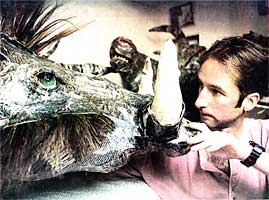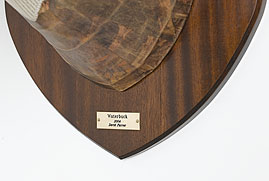‘MOUNTED BUT NOT STUFFED’ includes a wonderful and varied menagerie of extraordinary creatures by the successful British artist David Farrer; his amazing and unique papier mache trophy heads have delighted audiences everywhere and won him international acclaim.
‘My favoured subject matter is ecological, having a strong interest in ‘green’ issues. My work reflects this. The recycled head concept came about in 1995 while working in South Africa. Over the years I have travelled extensively in this part of the world and never cease to be amazed by its beauty and abundant wildlife…. There are admirable wildlife protection policies in operation, yet hunting and specifically trophy gathering remains big business too. I decided to bridge the gap by producing a ‘recycled trophy’ that would satisfy the urge to hang an animal head on the wall but promote pro-ecological thought…Although the idea was born in Africa I have diversified into European and North American beasts, which to some sections of the public have more familiar appeal.’ David Farrer 2001
David has deliberately emulated the style of the Victorian and Edwardian hunting trophy. Starting with weeks of painstaking work using single strand wire and layer upon layer of critically placed papier mache strips, the completed heads are mounted on magnificent, traditional French polished shields, the wood for which is carefully sourced from sustainable forests, and finished off with a period style engraved brass plaque. These papier-mache wonders defy their humble medium, yet through the advertent use of text, which covers them, there is a constant reminder of their genuine recycled nature. Words and headlines are carefully selected from discarded colour supplements and positioned on the work to intrigue, challenge, delight and always engage the viewer. The use of the media’s current written material makes the sculpture very ‘of it’s time’, a 3D display of contemporary history, a social commentary of today in montage style, wrapped around the form of that which now falls in a world of taboos, but also exudes nostalgia from an era gone by. Here we have the past and the present stitched together in these beautifully crafted, contemporary creations. Likenesses can be uncanny in their perfection, but a twinkle of humour is always present, inviting debate on that which the sculpture clearly mocks.
There is also a cheeky playfulness to David’s work, such as the ‘Seated Warthog’; the anthropomorphism of his creatures fills them with character and invites us to relate to them as equals. Even the trophy heads, a direct result of hunting, when the genuine article are here gently animated with personality and thus very much alive.
These happy, environmentally friendly sculptures appear at first, a light-hearted alternative to the real thing, but it is also a vehicle for a stronger and more serious message. David’s work focuses on the recyclable and the sustainable conveying his key concerns for conservation and ecology while celebrating a deep love of wildlife and the countryside.
The ‘For Fox Sake’ series ironically explores, swapping the hunted for the hunter and making the huntsman the trophy. This idea is in response to February’s banning of this contentious ‘sport’. In one of the pieces the huntsman is mockingly mounted on a shield, his ears like trophy cup handles, defining his transition from hunter to quarry.
A variety of animal bums with strategically placed Oxpeckers have over the years been treated to the same trophy status, skilfully mounted on shields. The bums are a call to conservation, a reminder of the tail end of a species, as humans push so many of the world’s most magnificent creatures to the edge of extinction. The art critic Carol Cordrey in a recent review made poignant comment on this; ‘….A trophy rhino’s bum was equally humorous, but unsettling too. Was I looking merely at an amusing rear view, or at wildlife that has turned its back on humans in despair? David’s art elevates animals both literally and metaphorically and thereby challenges our attitudes towards them.’
The Dodo is an animal of great appeal to David Farrer; applying his eco friendly, recycled material approach to them seems deliciously apt. They highlight his concern for conservation and celebrate those creatures that have been lost to us through man’s carelessness. There is also a wonderland sense of the surreal and mystery to the Dodo that goes beyond Alice’s dream lands and feeds all our imaginations with ideas of magical beasts of beauty that are no longer here for us to see.
David enjoys a sense of the ludicrous, so along side his African Game heads, which at times are uncomfortably realistic, are farmyard animals that we would certainly not expect such a confrontation with. Huge half pigs trotting across the wall offer a satirical take with a farcical, humorous twist on the ‘Flying Ducks’, which have populated many a façade since the 1950s. And giant chickens, such as ‘Crowing Cock’ who wears a feathered coat of recent text on bird flue, or ‘G.M. Chicken’ (Genetically Modified), highlighting man’s dabbling with nature. It all makes us laugh but a social commentary weaves its way through every piece. The sculpture is used to raise a point and provoke thought.
‘I’m Mandy, Fry Me’ was created in 2001 in response to the Tamworth Two and a following less publicised pig story. When the two Tamworth pigs escaped the slaughterhouse and went on the run this caught the media’s attention and by the time the celebrity couple were captured the public demanded their happy retirement to an animal sanctuary rather than a return to the slaughterhouse they had run from. Some months later a couple of Yorkshire Whites tried to flee a similar gruesome fate, and though this did not achieve such media notoriety the press still covered it and the public response was for their freedom also. Sadly these fellows were not to be spared the knife. A spokesman explained to a disheartened audience that these pigs were bred for high yield meat and were they to reach their full weight their hearts would not be strong enough. How man dabbles with nature for his own gain is often very disturbing. David Farrer brought humour to this sad tail by conveying with heart wrenching irony the sheer prostitution of the pig for bacon!
When David was offered a cross cultural exhibition in France in 2001, being aware of the shared history and ‘entente cordiale’ between these two great nations he decided to export several sheep and cow sculptures to celebrate our much loved mutual trade links. The work, along with its Hogarth-esque irony, mirrored the sad events of the day; ‘foot and mouth’ was decimating the landscape, the eerie headlines for which shrouded a collection of unfortunate beasts.
David has been making the trophy heads for the last 10 years now and has enjoyed great acclaim, his work in public and private collections all over the world and decorating the homes of many celebrities. David and his work have featured on many national and local TV and radio programmes including ‘Rolf on Art’, BBC’s Backstage Pass, BBC’s Smart, the children’s art programme, and CBBC’s daily Exchange show. His accessible, uncanny beasts speak in tongue to a wide and very varied audience; they never fail to provoke thought, laughter and deep appreciation.
‘From wire, magazines, newspapers, wood and horse-hair, David Farrer uses papier-mache to transform these materials into vibrant and dramatic sculptures that succeed in confronting and, to some degree breaking down the barrier between traditional craft and contemporary fine art.’ Dr. Sharon-Michi Kusunoki, West Dean College, 2004.
Cordelia John, December 2005
We have taken advice from Museums and paper conservators with regard to maximising the life span of the sculptures. In accordance with their advice, each piece is coated inside and out with pva glue in order to bind and seal the paper layers.
The exterior of the work is then hand-painted with polyurethane varnish to give it a tough durable coating; the work can therefore be easily maintained.
Although thoroughly sealed the sculptures are not suitable for exterior display.
The shields are manufactured to order by a local joinery, using sustainable-farmed African Utile hardwood. They are then traditionally French polished by hand and finished off with an engraved brass plaque.


